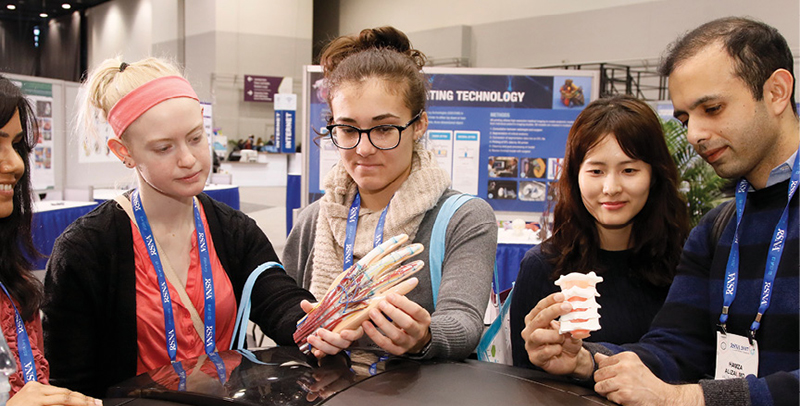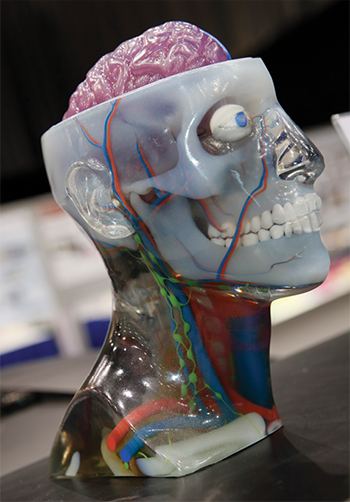3D Printing RSNA 2018
As 3D printing technology continues to evolve, read how radiology will be involved in managing digital workflow related to patient care.

“3D printing is a part of medicine, and radiology is at the center of this impactful new technology,” said RSNA 3D Printing Special Interest Group (SIG) Chair Jane Matsumoto, MD, assistant professor of radiology and co-director of the 3D Printing Lab at the Mayo Clinic, Rochester, MN. “Many radiologists see 3D printing as an evolving part of their practice; an innovative new way to display imaging, contribute to patient care and offer clinical value to their medical and surgical colleagues.”
And as the technology continues to evolve, 3D printing could bring radiology to the next level in the health care industry.

“Being embedded in the health care system, radiologists are uniquely positioned to manage the entire digital workflow — from imaging acquisition to the eventual 3D-printed product,” added SIG member Jenny Chen, MD, adjunct clinical faculty, Department of Radiology, Stanford Health Care.
As 3D printers become cheaper and the learning curve is less steep, radiologists are using the technology for more types of models and to simulate procedures than ever before.
For example, radiologists can now use a patient’s own imaging data to print 3D anatomic models that serve as aids in complex surgeries and for simulation training. 3D printing is also being used to create individualized osteotomy cutting guides to contribute to precision surgery. The technology has even started to find its way into such areas as renal sparring surgery, prostate cancer treatment, tracheal reconstruction and lung segmentectomy.
“Within radiology, there are biomedical engineering opportunities for the development of customized medical devices, prostheses and phantoms based on imaging data,” Dr. Matsumoto said.

Many of these developments will be highlighted at RSNA 2018.
“Daily didactic sessions will cover everything from the basics of starting a 3D printing lab within radiology to practical applications, quality assurance, research and education,” Dr. Matsumoto said.
Highlights include a number of hands-on sessions and a U.S. Food and Drug Administration-led discussion on the agency’s oversight of 3D printing. The Informatics Community in the Learning Center will host a self-directed exhibit on the 3D Printing SIG.
In addition, a variety of posters and education exhibits in all subspecialties including 3D printing content will be presented throughout the meeting.
3D Printing & Advanced Visualization at RSNA 2018
The 3D Printing & Advanced Visualization Showcase will be located on the Technical Exhibits floor in the South Hall. Previously, the showcase was located in the Learning Center.
This year’s showcase will feature daily sessions, a display of 3D-printed artifacts and exhibitors featuring the latest 3D imaging and advanced visualization products. The 3D Printing SIG will offer a variety of lectures in the showcase and throughout the meeting.
To learn more, visit Meeting Central at Meeting.RSNA.org.
The 3D Printing & Advanced Visualization Showcase is sponsored by TeraRecon.

In Focus: The RSNA 3D Printing SIG
The RSNA 3D Printing SIG has grown rapidly since its founding in 2016. Today, its 380 active members include radiologists, engineers, physicists, technologists and representatives from the 3D printing industry. Some of the group’s recent accomplishments include:
- Establishing 3D Printing Consensus Guidelines
- Developing 3D Printing Appropriateness Criteria for clinical use
- Integrating 3D printing STL files into DICOM
- Communicating with the FDA on their evolving oversight of 3D printing for patient care
- Working toward reimbursement
- Organizing educational opportunities for members, including meetings and conferences,
a dedicated website and a bi-monthly newsletter.
Learn more: RSNA.org/3D-Printing-SIG
3D Printing Courses at RSNA 2018
RSNA 2018 offers a range of informational sessions and opportunities to get hands-on experience with 3D printing technology:
- Teaching Congenital Heart Morphology with 3D Print Models II: Understanding Surgical Procedures in Congenital Heart Diseases with Illustrations and 3D Print Models (Hands-on)
- 3D/VR/AR Imaging: Staying on the Cutting Edge of Brain Anatomy/Pathology (Hands-on)
- Introduction to 3D Medical Printing
- Creating Patient-Specific Anatomical Models for 3D Printing and AR/VR(Hands-on)
- Image to 3D Prints: How 3D Printing Works (Hands-on)
- 3D Medical Printing Applications I
- 3D/VR/AR Imaging: Staying on the Cutting Edge of Brain Anatomy/Pathology (Hands-on)
- 3D Medical Printing Technologies
- 3D Printing Hands-on with Open Source Software: Introduction (Hands-on)
- 3D Medical Printing Applications II
- Image to 3D Prints: How 3D Printing Works (Hands-on)
- Creating Patient-Specific Anatomical Models for 3D Printing and AR/VR (Hands-on)
- Virtual Reality and 3D Printing
- 3D Printing Hands-on with Open Source Software Introduction (Hands-on)
- Transpositions of the Great Arteries in Your Hands (Hands-on)
Sunday, Nov. 25
Monday, Nov. 26
Tuesday, Nov. 27
Wednesday, Nov. 28
Thursday, Nov. 29
Learn About the 3D Printing Special Interest Group at RSNA 2018
Interested in knowing more about 3D printing for your practice? Visit the RSNA 3D Printing Special Interest Group (SIG) kiosk located in the Informatics Community in the Learning Center to learn about medical 3D printing and the basics of setting up a lab. Attendees can also learn about the SIG’s activities, access 3D printing resources and learn how to connect with the medical 3D printing community.
